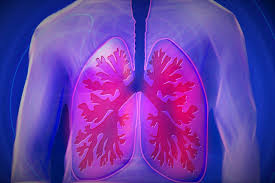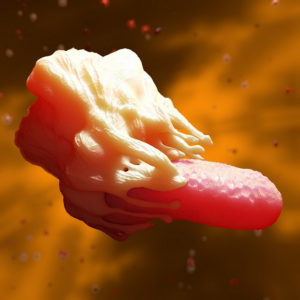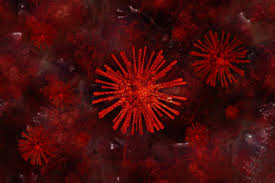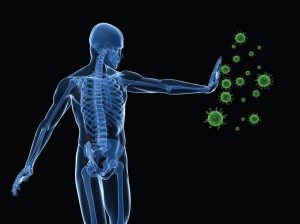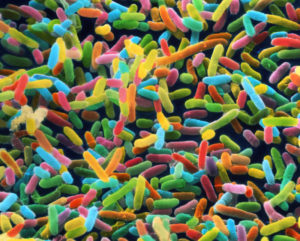Abstract
We present a bioprinted three-layered airway model with a physiologically relevant microstructure for the study of severe acute respiratory syndrome coronavirus 2 (SARS-CoV-2) infection dynamics. This model exhibited clear cell-cell junctions and mucus secretion with an efficient expression of angiotensin-converting enzyme 2 (ACE2) and transmembrane serine protease 2 (TMPRSS2). Having infected air-exposed epithelial cells in the upper layer with a minimum multiplicity of infection of 0.01, the airway model showed a marked susceptibility to SARS-CoV-2 within one-day post-infection (dpi). Furthermore, the unique longevity allowed the observation of cytopathic effects and barrier degradation for 21 dpi. The in-depth transcriptomic analysis revealed dramatic changes in gene expression affecting the infection pathway, viral proliferation, and host immune response which are consistent with COVID-19 patient data. Finally, the treatment of antiviral agents, such as remdesivir and molnupiravir, through the culture medium underlying the endothelium resulted in a marked inhibition of viral replication within the epithelium. The bioprinted airway model can be used as a manufacturable physiological platform to study disease pathogeneses and drug efficacy.
Introduction
With a threat to public health, severe acute respiratory syndrome coronavirus 2 (SARS-CoV-2) and its emerging variants resulted in a devastating global pandemic, with over 775 million confirmed cases and 7.1 million deaths worldwide by 2024 [1]. Although most individuals infected with SARS-CoV-2 experience mild to moderate respiratory symptoms with viral replication mainly confined to the upper respiratory tract, some patients develop life-threatening pneumonia due to its ability to spread to the lower respiratory tract. Related to its pathogenesis, tissue tropism studies have demonstrated that SARS-CoV-2 targets several types of epithelial cells that express angiotensin-converting enzyme 2 (ACE2), that is a receptor molecule to the spike protein, and transmembrane protease serine subtype 2 (TMPRSS2), that is essential for virus-cell fusion, on their apical membrane [2,3]. The upper airway epithelium in the nasopharynx and trachea expresses both ACE2 and TMPRSS2 abundantly, and is therefore highly susceptible to the incoming SARS-CoV-2 [4]. After entry into cells, the viral RNA genome directly triggers translation of viral proteins, resulting in the production of new viral particles [5,6]. At this early stage, if the host immune system fails to control the viral life cycle by stimulating the expression of interferons and pro-inflammatory cytokines, or to eliminate virus-infected cells by recruiting immune cells, the amplified viral progeny will spread to the lower respiratory tract. It can be monitored through pathological analysis, observing the presence of tissue integrity loss and detachment of tissue fragments in lung biopsy samples [7,8].
The human airway system, spanning from the nasal cavity to the terminal bronchioles and alveoli of the lungs, is lined with epithelium exposed to the air and vascular endothelial surface in contact with blood vessels [9,10]. Between the epithelium and the endothelium lies the basement membrane, an extracellular matrix (ECM), which is predominantly composed of collagen secreted by fibroblasts. The ECM is mechanically stable, thus maintaining the overall scaffold of the airway tissues, yet flexible, with the ability to remodel the injured tissues by activating the coagulation cascade. In addition to its fundamental role in regulating tissue homeostasis, the pulmonary ECM of the lower airway acts as a frontline defense against respiratory pathogens by forming a layer of physical barrier to viral entry and regulating the host immune system [11,12]. To develop antiviral or immunoregulatory molecules, it is essential to understand viral pathogenesis in a physiologically relevant system that supports SARS-CoV-2 infection of air-liquid interface (ALI) cultured cells on the ECM basement and vascular endothelial cells.
The anatomical differences in airway tissues between humans and mice, coupled with ethical concerns surrounding animal experimentation and the limitations of conventional animal models not susceptible to human-infecting viruses, highlight the pressing need to enhance in vitro respiratory cell culture systems that are more sophisticated for understanding human-SARS-CoV-2 interactions or for measuring antiviral activity [[13], [14], [15]]. Such a model should ideally recapitulate several key features of the in vivo airway. First, the model places a high priority on establishing a physiologically relevant multilayered barrier that mimics the interface between internal human organs and the external environment. Conceptually, for antiviral evaluation, the 3D culture model needs to allow viral access to the apical surface, but drug delivery to the target cells by sequential penetration of the vascular endothelium and the ECM. Secondly, the model should be reconciled to an air-exposed tissue culture, as one of the most remarkable features of the airway epithelium is its surface directly exposed to the external environment [15]. Next, the model should exhibit high susceptibility to SARS-CoV-2, even with minimal exposure to viral particles, in order to allow assessment of antiviral activity during multiple rounds of viral replication. This can be achieved by ensuring sufficient and widespread expression of host factors that regulate the viral entry, such as ACE2 and TMPRSS2, on the epithelial cell membrane. Finally, the model is required to support long-term tissue culture to facilitate time-course studies of the effects of gene expression by SARS-CoV-2, pathological damage potentially related to the long-lived virus, and the longitudinal response to antivirals.
Although numerous in vitro models, such as 2D cell cultures [[16], [17], [18]], organoids [[19], [20], [21]], and lung chips [[22], [23], [24], [25]], have been used to study viral infections and evaluate antiviral efficacy, these models do not fully address all of these important requirements. For examples, organoids with a cell composition similar to actual human lungs are developed by spontaneously differentiating stem cells. While organoids can provide tissue-specific functions, it is difficult to standardize their cellular composition and size for drug screening. Additionally, the closed cellular structure of organoids precludes air-exposed culture and viral access to the apical epithelium, disturbing viral tropism and requiring high-dose of SARS-CoV-2 inoculation. Lung chips offer several advantages, such as a circulating medium under the vascular endothelial layer, mimicking the bloodstream in the human lung. They enable the infection of viruses in the apical epithelium and drugs in basolateral endothelium. However, manufacturing models that ensure uniformity among samples is challenging due to the difficulty in accurately controlling the location of cells. Moreover, the synthetic porous membrane between the epithelial and endothelial layer cannot recapitulate interactions between the virus and ECM, such as virus retention within the ECM [[26], [27], [28]]. These models are not suitable for studying the long-term host response to SARS-CoV-2 infection as the virus causes cell death within approximately 4 days post-infection (dpi).
Here, we demonstrate that bioprinted multilayer airway models composed of endothelium, ECM, and human lung cell-derived epithelium, successfully recapitulating a physiologically relevant lower respiratory system. We investigated some markers specific to each layer within the miniaturized airway tissue and analyzed the expression of SARS-CoV-2 entry mediators, representatively ACE2 and TMPRSS2. We challenged SARS-CoV-2 infection on the airway model to elucidate the associated pathological changes and the effect of SARS-CoV-2 on host mRNA expression at the transcriptome level. Furthermore, this research aims to assess its feasibility as an antiviral assay system by using the antiviral reliability of FDA-approved direct-acting antivirals, remdesivir and molnupiravir. From these comprehensive investigations, we aspire to contribute to the development of innovative options for the control of emerging coronaviruses or other respiratory infections, where the efficacy of antiviral or immunoregulatory molecules can be measured by reflecting their delivery through the airway capillary-ECM-epithelium barrier.
Section snippets
3D bioprinting of physiologically relevant airway constructs
Our multilayered airway architecture was designed to mimic the in vivo airway structure (Fig. 1A) by bioprinting vascular endothelial cells, collagen-based extracellular matrix, and lung epithelial cells directly onto a porous membrane culture insert (Fig. 1B). In this construct, we expected that SARS-CoV-2 would infect the apical region of the epithelial cells and subsequently spread to neighboring cells. Since the antivirals were administered into the basolateral part, the model was capable
Discussion
As an effective platform for studies on viral infection, 3D-bioprinted ALI cultured model features a three-layer architecture that recapitulates the complexity of the in vivo respiratory system. With a discovery that air-exposed epithelial cells and vascular endothelial cells interact through a natural ECM composed of fibronectin, collagen Ⅰ, Ⅳ, and laminin (Fig. 2A), it distinguishes itself from other models by allowing long term observation of coordinated interactions among the three core
Cell culture
HULEC-5a cells (ATCC, VA, USA) were expanded in MCDB 131 (Thermo Fisher Scientific, MA, USA) medium supplemented with 10 ng/ml human epidermal growth factor (EGF) recombinant protein (Thermo Fisher Scientific), 10 mM l-glutamine (Sigma-Aldrich, MO, USA), 1 μg/ml hydrocortisone (Sigma-Aldrich), 10 % (v/v) fetal bovine serum (FBS; Cytiva, MA, USA), and 1 % (v/v) antibiotic/antimycotic solution (Cytiva). MRC-5 cells (ATCC) were expanded using MEM alpha modification (Cytiva) containing 10 % FBS and
CRediT authorship contribution statement
Yunji Lee: Writing – review & editing, Writing – original draft, Visualization, Methodology, Investigation, Conceptualization. Myoung Kyu Lee: Writing – review & editing, Writing – original draft, Visualization, Methodology, Investigation. Hwa-Rim Lee: Writing – review & editing, Writing – original draft, Visualization, Methodology, Investigation. Byungil Kim: Writing – review & editing, Investigation. Meehyein Kim: Writing – review & editing, Writing – original draft, Visualization,
Declaration of competing interest
The authors declare that they have no known competing financial interests or personal relationships that could have appeared to influence the work reported in this paper.
Acknowledgements
This work was supported by the National Research Foundation of Korea grant (NRF-2022R1A2C2012272) funded by the Korean government (MSIT) and the Korea Health Industry Development Institute (KHIDI; HI23C0721 to M.K.) funded by the Korean government (MHW)…

